KYORITSU 6315 Quick Manual
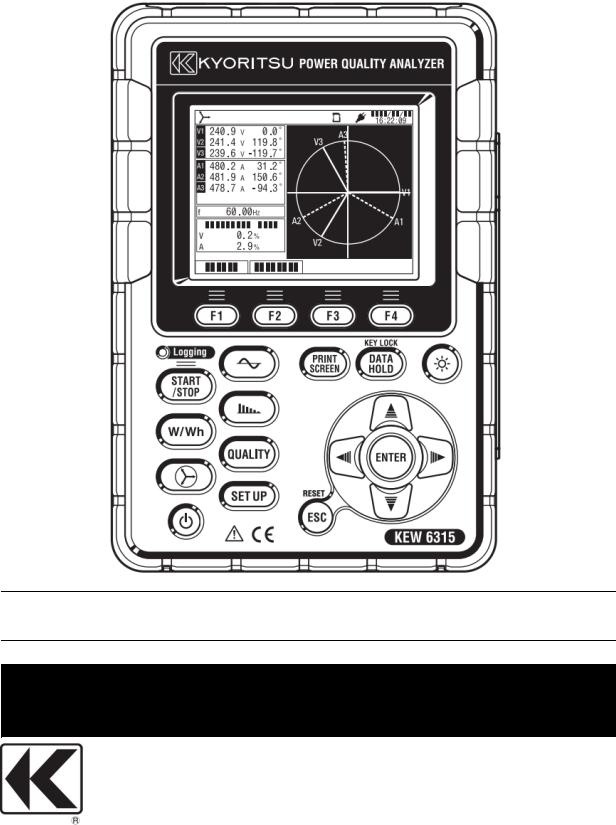
Quick Manual
POWER QUALITY ANALYZER
KEW6315
KYORITSU ELECTRICAL INSTRUMENTS WORKS, LTD.
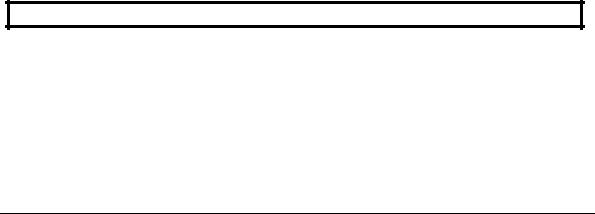
Preface |
KEW6315 |
●Preface
This Quick manual is a simplified version of the full instruction manual which can be found in the supplied CD-ROM. This manual is intended only as a handy reference guide and should only be used after having read the full instruction manual which contains full details on each function of this instrument and the items contained in the package.
●Safety Warning!
The instruction manual contains warnings and safety procedures which have to be observed to ensure safe operation of the instrument and maintain it in a safe condition. Thus, these operating instructions have to be read prior to using the instrument.
Content
1.Instrument Overview 2
2.Start/ Stop Recording  5
5
3.Instrument Layout 13
4.Getting Started 17
5.Inst/ Integration/ Demand 
Inst value : W 19 Integration value: Wh/ Demand 21
6.Vector  25
25
7.Waveform  26
26
8.Harmonics Analysis  27
27
9.Power Quality 
Event(Swell/ Dip/ Int/ Inrush current/ Transient) 30 Flicker 33
10.Setting  35
35
11.SD Card/ Saved Data 38
The latest software can be downloaded from our homepage: http://www.kew-ltd.co.jp.
- 1 - |
KEW6315 |

KEW6315 Feature
1.InstrumentOverviiiew
Feature
This is a Clamp-type Power Quality Analyzer that can be used for various wiring systems.
It can be used for simple measurements of instantaneous/ integration/ demand values, and also for analysis of harmonics and events related to power quality and for the simulation of power factor correction with capacitor banks. Moreover, it can display waveforms and vectors of voltage and current. Data can be saved either in the SD card or the internal memory, and can be transferred to PC via USB, or in real time via Bluetooth communication.
Safety construction
Designed to meet the international safety standard IEC 61010-1 CAT.IV 300V/ CAT.III 600V/ CAT.II 1000V. Power quality analysis
KEW6315 is designed to meet the international standard IEC61000-4-30 Class S and can measure frequency and r.m.s. voltage with high accuracy, and also can analyze harmonics. Moreover, it can measure swell, dip, interruption, transient, inrush current and flicker all at once without a gap.
Power measurement
KEW6315 measures active/reactive/apparent power, electrical energy, power factor, r.m.s. current, phase angle and neutral current simultaneously.
Wiring configuration
KEW6315 supports: Single-phase 2-wire (4ch), Single-phase 3-wire (2ch), Three-phase 3-wire (2ch) and Three-phase 4-wire.
Demand measurement
Electricity consumption can be easily monitored so as not to exceed the target maximum demand values. Waveform/ vector display
Voltage and current can be displayed by waveform or vector.
Saving data
KEW6315 is endowed with a logging function with the preset recording interval. Data can be saved by manual operation or by specifying date & time. Screen data can be saved by using the Print Screen function.
Dual power supply system
KEW6315 operates either with AC power supply or with batteries. Both dry-cell batteries (alkaline) and rechargeable batteries (Ni-MH) can be used. To charge the rechargeable battery, use the charger which is manufactured by the same company as the batteries. In the event of power interruption, while operating with
AC power supply, power to the instrument is automatically restored by the batteries in the instrument. Large display
TFT color display with large screen.
Light & compact design
Clamp sensor type, compact and light weight design.
Application
Data in the SD card or the internal memory can be saved in PC via USB. Analysis of the downloaded data and instrument settings are possible by using the special software “KEW Windows for KEW6315”. Real-time communication is available via Bluetooth.
Input/ Output function
Analog signals from thermometers or light sensors can be measured simultaneously with electrical power data via 2 analog inputs (DC voltage); when any events related to power quality occur, signals can be transmitted to alarm devices via one digital output.
KEW6315 |
- 2 - |

Functional overview |
KEW6315 |
Functional overview
Start/ Stop
Choose either “Quick start guide” or “Start now” to start recording. Can do simple and fast start-up setti ng by selecting “Quick start guide”.
See “2. Start/Stop Recording” for further details.
Inst/ Integration/ Demand
Display the avg/ max/ min instantaneous values of current/ voltage/ active power/ apparent power/ reactive power. Integration values also can be viewed by switching screens. Moreover, demand values with the preset target value can also be checked.
See “5. Inst/ Integration/ Demand” for further d etails.
Vector and Wiring check
Vectors of voltage and current per CH are displayed on a graph. KEW6315 will perform wiring check.
See “6. Vector” for further details.
- 3 - |
KEW6315 |
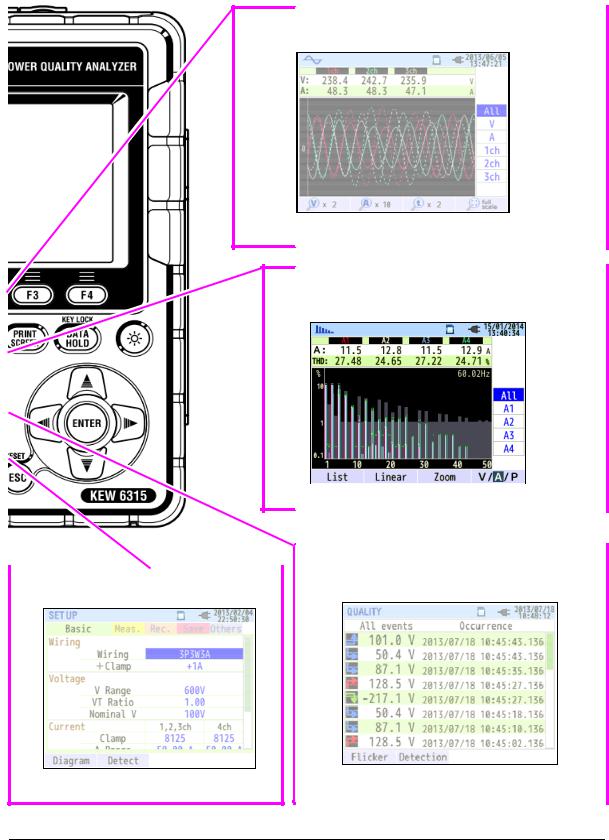
KEW6315 |
Functional overview |
Wavefform
Waveformms of voltage and current per CH are displayed on a graph.
See “7. W aveform” for further details.
Harmonic Analysis
Harmonic components of voltage and current per CH are displayed on a graph.
See “8. Harmonic Analysis” for further details.
|
Power Quality (QUALITY) event |
|
Setting (SET UP) |
Display voltage swell, dip, int, transient, inrush current |
|
and flicker. |
||
Make settings for KEW6315 and measurements. |
||
|
See “10. Setting” for further details.
See “9. Power Quality” for further details.
KEW6315 |
- 4 - |
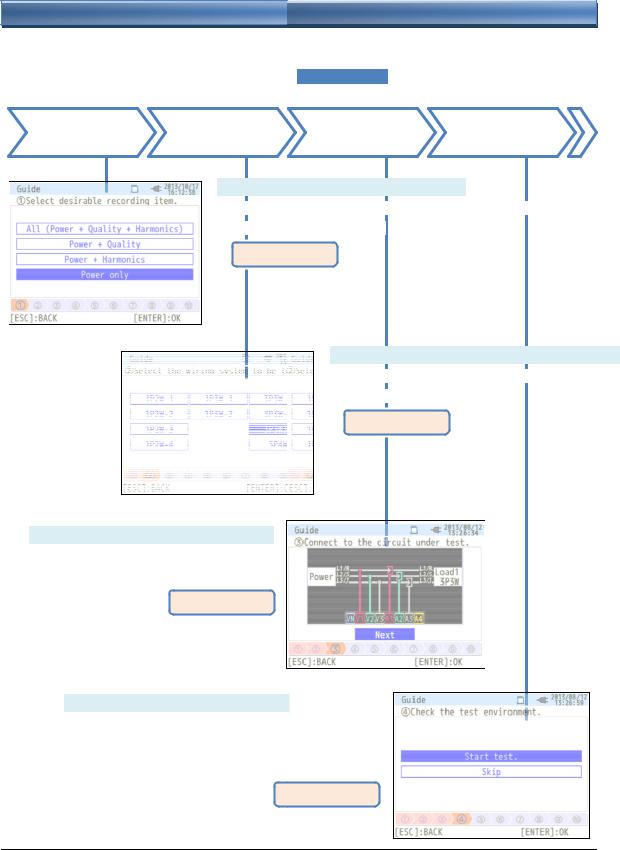
Start/ stop recording |
KEW6315 |
2.Start/StopRecordiiing
 Steps for measurement
Steps for measurement
Can start recordings with simple steps by selecting “Quick start guide”.
Ensure your safety and do the appropriate preparaations before starting measurements.
Select the |
Select the |
Confirm the |
Check the test |
recording item |
wiring system |
connections |
environment |
(1)Select the item you want to record.
* The numbber of selected items will have effect on file size and also on max recording time.
See P.40.
(2) Select the wiring system to be measured.
* Select a proper wiring system for accurate
measurements.
See P.7.
(3)Connect to the circuit to be tested.
* Read and follow the safety precautions described in the instruction manual.
See P.17.
(4)(5) Check the Test environment.
*Self-diagnosis, wiring check and detection of connected sensors will be performed in this test.
*It is recommended to do this test for ennsuring the testing
conditions are correct.
See P.8.
- 5 - |
KEW6315 |
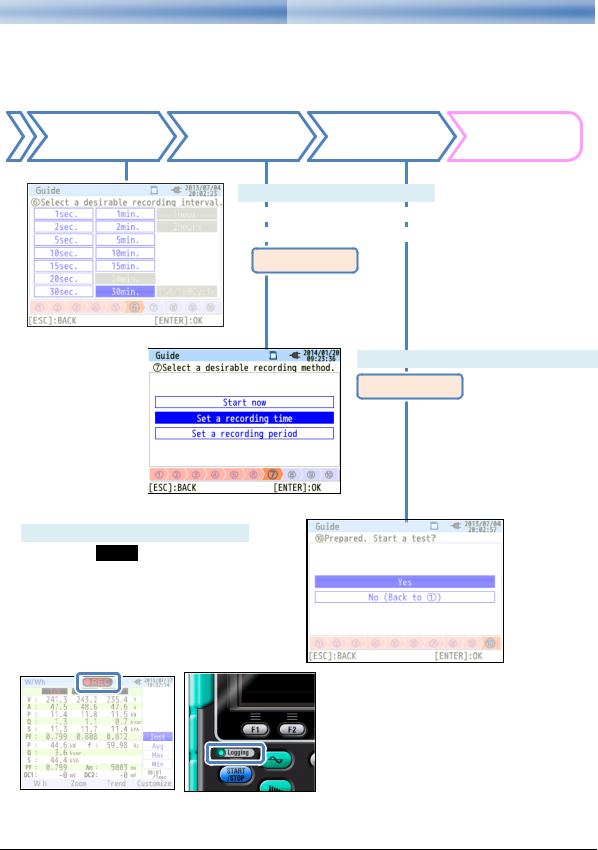
KEW6315 |
Start/ stop recording |
|||
|
|
|
|
|
|
|
|
|
|
|
|
|
|
|
Select the |
Select the |
Check the |
Start |
rec. interval |
rec. method |
selected method |
recording |
(6)Seleect a recording interval.
* Seleccting a short interval gets the file size large. In this case, a long period recording cannot be performed.
Seee P.38.
(7)(8)(9) Select a recording method.
See P.11.
(10) Prepared. Recording will start.
The mark “ REC ” will appear on the screen when the recording starts and the green LED (status indicator) lights up.
If you want to terminate the recording, press the “ ” button and follow the instructions displayed on the screen.
” button and follow the instructions displayed on the screen.
KEW6315 |
- 6 - |
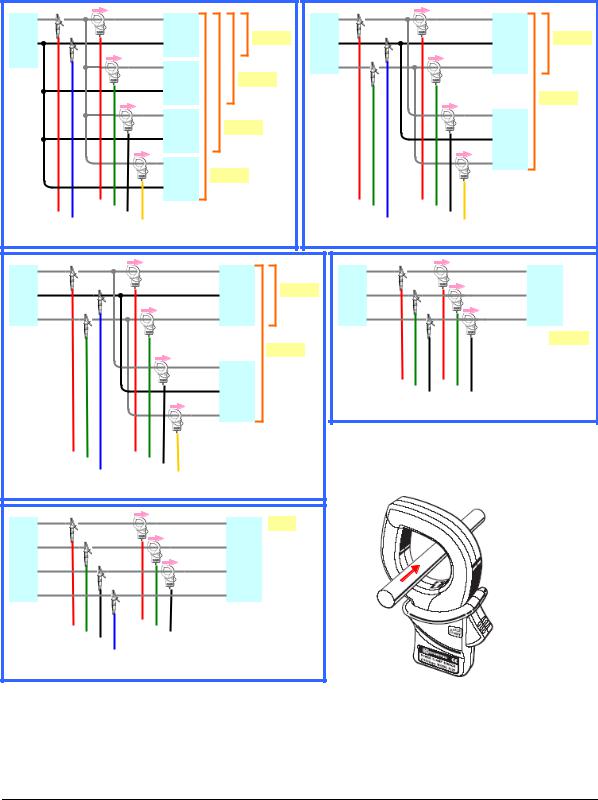
Wiring system |
KEW6315 |
(2) Wiring system
Any of the followings can be selected.
|
L |
L |
Load |
|
|
|
|
Power supply |
|
|
|
|
supply |
||
N |
N |
(1) |
|
1P2W×1 |
|||
|
|
|
|||||
|
|
1P2W |
|
|
|||
|
|
|
|
|
|
|
|
|
|
L |
Load |
|
1P2W×2 |
|
|
|
|
N |
(2) |
|
|
||
|
|
|
|
|
|
||
|
|
L |
1P2W |
|
|
|
|
|
|
Load |
|
|
|
|
|
|
|
|
|
1P2W×3 |
|
|
|
|
|
N |
(3) |
|
|
|
|
|
|
|
|
|
|
||
|
|
L |
1P2W |
|
|
|
|
|
|
Load |
|
|
|
|
|
|
|
|
1P2W×4 |
|
|
||
|
|
N |
(4) |
|
|
||
|
|
|
|
|
|
||
|
|
|
1P2W |
|
|
|
|
|
A1A2 |
|
|
|
|
|
|
|
V1VN |
A3A4 |
|
|
|
|
|
|
L1(R) |
|
L1(R) |
|
|
|
|
Power supply |
L3(T) |
|
L3(T) |
Load |
|
|
|
|
3P3W |
|
|
||||
|
L2(S) |
|
L2(S) |
(1) |
3P3W×1 |
||
|
|
|
|
|
|
3P3W×2 |
|
|
|
|
L1(R) |
|
|
|
|
|
|
|
L2(S) |
Load |
|
|
|
|
|
|
(2) |
|
|
||
|
|
|
L3(T) 3P3W |
|
|
||
|
V1V2 |
A1A2 |
|
|
|
|
|
|
VN |
A3A4 |
|
|
|
|
|
Power |
L1(R) |
|
L1(R) |
|
3P4W |
|
|
|
|
|
|
|
|
||
L2(S) |
|
L2(S) |
Load |
|
|
||
supply |
N |
|
|
N |
3P4W |
|
|
|
L3(T) |
|
L3(T) |
|
|
||
|
V1 |
A1A2 |
|
|
|
|
|
|
V2V3 |
|
A3 |
|
|
|
|
|
VN |
|
|
|
|
|
|
|
L1 |
|
|
|
L1 |
|
||
Power |
L2 |
|
|
|
|
Load |
|
|
|
|
|
L2 1P3W |
|
||||
|
N |
|
|
|
|
N |
(1) |
1P3W×1 |
|
|
|
|
|
|
|
|
|
|
|
|
|
|
|
L1 |
1P3W×2 |
|
|
|
|
|
|
|
|
||
|
|
|
|
|
|
N |
Load |
|
|
|
|
|
|
|
|
(2) |
|
|
|
|
|
|
|
L2 1P3W |
|
|
|
V1V2 |
A1A2 |
|
|
||||
|
|
|
VN |
|
|
A3A4 |
|
|
|
supply |
Power |
L1(R) |
|
|
|
L1(R) |
|
|
L2(S) |
|
|
|
L2(S) |
Load |
||
|
|
|
|
|
|
|||
|
|
|
|
|
|
|
|
3P3W |
|
|
|
L3(T) |
|
|
|
L3(T) |
|
|
|
|
|
|
|
|
|
3P3W3A |
|
|
|
V1V2 |
A1A2 |
|
|
||
|
|
|
|
V3 |
A3 |
|
|
|
Orientation of Clamp sensor
Load
 Arrow mark: Point towards
Arrow mark: Point towards
load side.
Power source
Reverse clamping switches the symbols (+/-) for active power (P).
- 7 - |
KEW6315 |
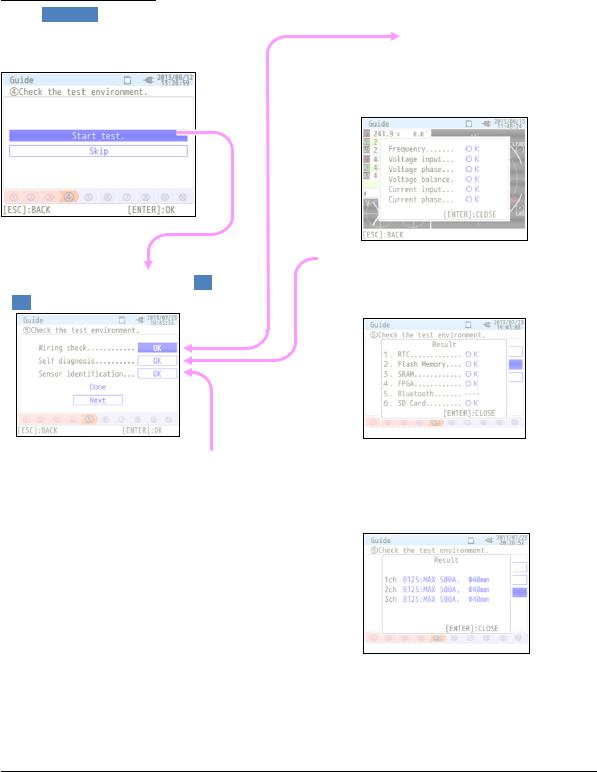
KEW6315 |
Environment check |
(4)/ (5) Test Environment Check
Test environment check
Select “ Start test ”and press the “ENTER”
button to start the test. The test result will be displayed on the screen.
Select and press the “ENTER” on “OK”/ ”NG” to see the details.
Wiring check
Test results of each item will be displayed.
* NG result may be given, even if the wiring is correct, at the measurement site under bad power factors.
 Self-diagnosis
Self-diagnosis
Operating condition of the instrument system will be checked and the result will be displayed.

 Sensor detection
Sensor detection
The connected sensors are automatically detected and their max Ranges will be set.
KEW6315 |
- 8 - |
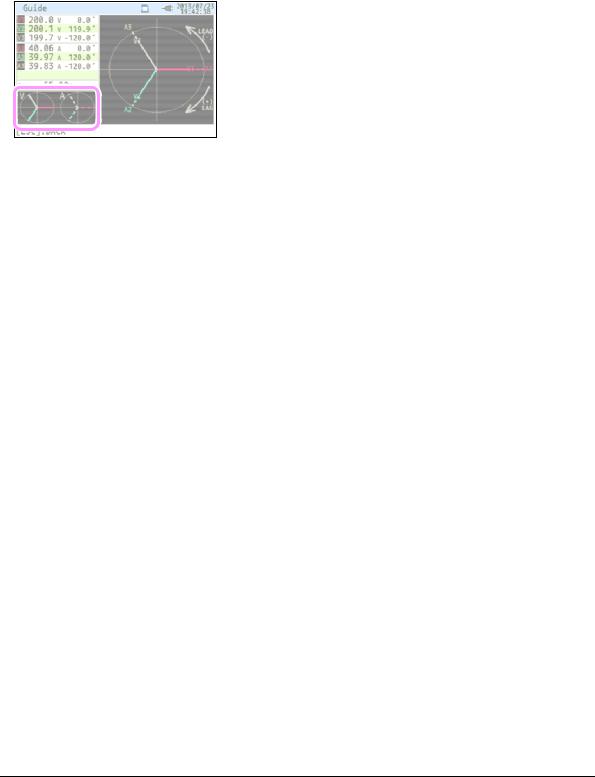
Wiring check |
KEW6315 |
NG judgment
Wiring check
Close the reesult display. Then, the blinking vectors and the values of NG items will be displayed. If all the results are OK, the ideal vector diagram will be displayed at the lower left corner.
Criteria of judgment and cause
Check |
Criteria of Judgment |
Causes |
|
|
Frequency of V1 is within 40 |
- Voltage clip is firmly connected to the DUT? |
|
Frequency |
- 70Hz. |
- Measuring too high harmonic components? |
|
|
|
|
|
|
AC voltage input is 10% or |
- Voltage clip is firmly connected to the DUT? |
|
AC voltage |
more of (Nominal voltage x |
- Voltage test lead is firmly connected to the |
|
|
|||
input |
VT). |
AC voltage input terminal on the instrument? |
|
|
|||
|
|
|
|
|
AC voltage input is within |
- Settings are matched with the wiring system under |
|
Voltage |
±20% of reference voltage |
teest? |
|
(V1). |
- Voltage clip is firmly connected to the DUT? |
||
balance |
|||
* (not checked in |
- Voltage test lead is firmly connected to the |
||
|
|||
|
single-phase wiring) |
AC voltage input terminal on the instrument? |
|
|
|
|
|
|
Phase of AC voltage input is |
- Voltage test leads are properly connected? |
|
Voltage |
within ±10º of reference value |
(CConnected to proper channels?) |
|
|
|||
phase |
(proper vector). |
|
|
|
|
||
|
|
|
|
|
Current input is 5% or more |
- Clamp sensors are firmly connected to the Power |
|
Current |
and 110% or less of (Current |
input terminals on the instrument? |
|
|
|||
input |
Range x CT). |
- Setting for Current Range is appropriate for input levels? |
|
|
|||
|
|
|
|
|
- Power factor (PF, absolute |
- Arrow mark on the Clamp sensor and the orientation |
|
Current |
value) at each CH is 0.5 or |
of flowing current coincide with each other? |
|
more. |
(PPower supply to Load) |
||
phase |
|||
- Active power (P) at each |
- Clamp sensors are connected properly? |
||
|
|||
|
CH is positive value. |
|
- 9 - |
KEW6315 |
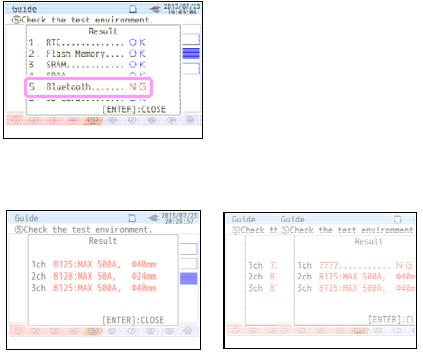
KEW6315 |
Self-diagnosis |
Self-diagnosis
If “NG” judgment is given frequently, there might be something wrong with the instrument. Stop using the instrument and refer to “Troubleshooting” in the instruction manual.
Sensor detection
If the detection result is NG, each sensor type will be displayed in red.
Criteria of judgment and cause
|
|
Causes |
|
|
Causes |
|
|
|
|
|
|
|
|
||
|
|
Check |
|
|
|
|
|
|
|
|
|
|
|
|
|
|
|
|
|
|
|
|
|
|
|
Type of |
|
- Types of the connected current sensors are harmonized? Types of the current |
|
||
|
|
current sensor |
|
sensors used for measurrements should be the same. |
|
||
|
|
|
|
|
|
|
|
|
??? |
|
|
- Current sensors are firmlly connected to the instrument? |
|
||
|
|
(cause unknown) |
|
- If any failures are in doubt: |
|
||
|
|
|
|
|
Exchange the connecttions of the sensors and test again. |
|
|
|
|
|
|
|
Connect the current sensor, for which "NG" is given, to the CH on which |
|
|
|
|
|
|
|
another sensor is propperly detected. |
|
|
|
|
|
|
|
If the result "NG" is givven for the same CH, a defect of the instrument is |
|
|
|
|
|
|
|
suspected. A defect of sensor is suspected if "NG" is given for the same |
|
|
|
|
|
|
|
sensor connected to another CH. |
|
|
|
|
|
|
|
Stop using the instrument and the sensor, if any defects are in doubt, and refer |
|
|
|
|
|
|
|
to "Troubleshooting" in the instruction manual. |
|
|
|
|
|
|
|
|
|
|
|
|
|
|
|
|
|
|
KEW6315 |
- 10 - |
|
|
||||
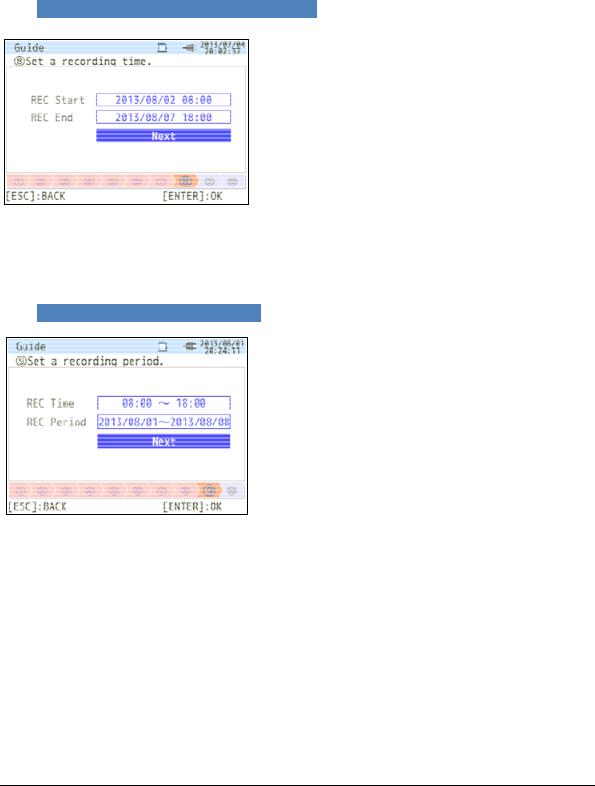
Setting for recording method |
KEW6315 |
(8)/ (9) Setting for recording method
The following explains how to set recording start da te and time.
(8) Specify the recording start date and time.
During the selected period, KEW6315 performs record ing at the preset intervals.
Example: When the date & time are specified as above, the recording period will be as follows. From 8:00 on August 2, 2013 to 18:00 on A ugust 7, 2013,
(9) Specify the recording time period.
KEW6315 performs recording during the selected time period at the preset intervals, and repeats recording processes during the preset time span.
Example: When the time period is specified as above, the recording period is as follows. KEW6315 does not record data between 18:00 and 8:00.
(i)8:00 to 18:00 on August 1, 2013,
(ii)8:00 to 18:00 on August 2, 2013,
(iii)8:00 to 18:00 on August 3, 2013,
(iv)8:00 to 18:00 on August 4, 2013,
(v)8:00 to 18:00 on August 5, 2013,
(vi)8:00 to 18:00 on August 6, 2013,
(vii)8:00 to 18:00 on August 7, 2013, and
(viii)8:00 to 18:00 on August 8, 2013.
- 1 1 - |
KEW6315 |
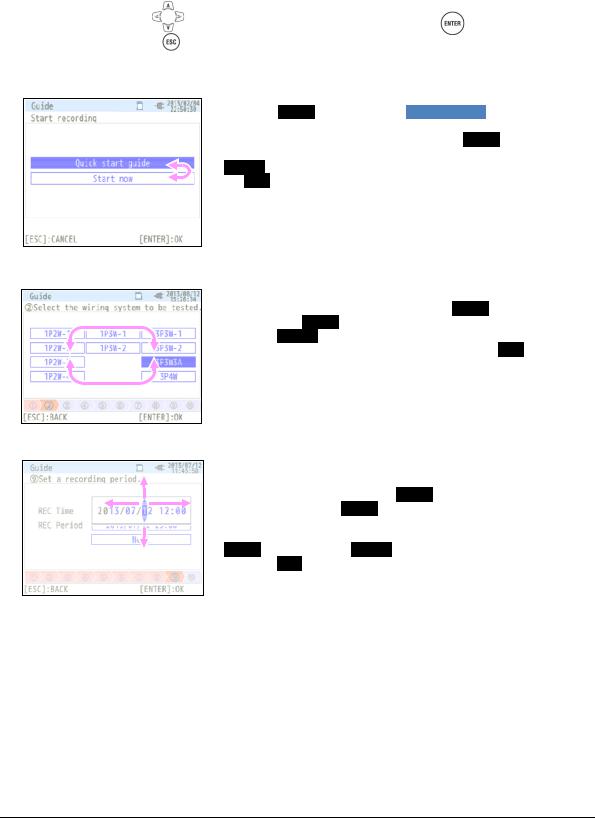
KEW6315 |
|
|
|
Operating procedure |
||||
Switching of displayed parameters |
|
|||||||
|
|
|
|
|
|
|
||
Basically, the |
Cursor |
Key |
is used for selectting an item, the |
ENTER |
Key |
is for confirming the |
||
|
|
|
|
|||||
selection, and the |
ESC |
Key |
is for canceling the alternation. Taking the procedures in “Quick Start |
|||||
Guide” as an example, Key operations are explaineed as follows.
Press the Cursor Key to move the blue highlight, showing the item is being selected, over the items in blue letters. In the screen at the left is the Recording start screen. Press the Cursor Key and move the blue highlight on the desirable recording method, and press the ENTER Keyy to confirm the selection. To quit the start guide, press the ESC Keey.
If the display of the selectable items is similar to the one shown to the left, thhen the up, down, right and left Cursor Keys can be used. Use thhe Cursor Keys to select the proper wiring system and press the ENNTER Key to confirm the selection. To return to the previous screen and cancel the changes, press the ESC Key.
To alter the numbers such as Date/ Time, move the blue highlight over digits with the right and left Cursor Keys and alter the number with the up and down Cursor Keys.
In the screen to the left, the tenth place of the day is being selected. The number can be increased or decreased by 1 with the up/ down Cursor Keys. Press the ENTER Key to confirm the selection, or press the ESSC Key to return to the previous screen and cancel
the changes.
KEW6315 |
- 12 - |
